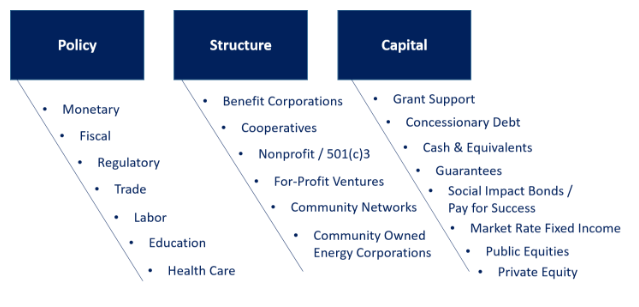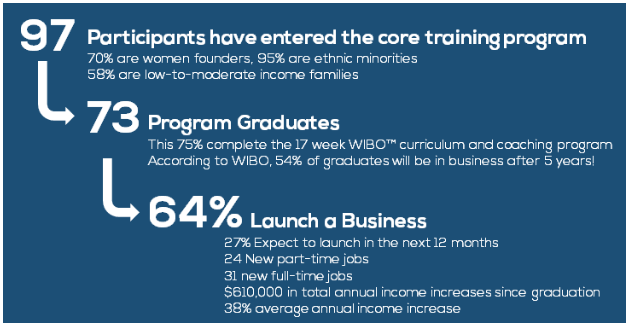

Investment and Policy for Sustainability
by Dale Fickett on the 20/09/2018
“No problem can be solved from the same level of consciousness that created it.”
Albert Einstein
The economy exists for the sole purpose of providing for the common welfare of all people. Fundamental issues have arisen in the economy, and we must acknowledge the relationship between society, economy and environment – changes to one aspect will naturally affect the others. It’s apparent that there are a range of challenges to conventional economics at two levels. First, there are symptoms, or unmet needs in the areas of water, food, housing, health care, education, and environmental damage. Second, there are systems of public policy, business strategy, resultant programs, and even fundamental methodology which are oftentimes based on false assumptions.
A necessary starting point is the difficult task of setting aside ideology, in recognition of the potential to drive returns on investment while ameliorating conditions of unmet need. To some it’s difficult to acknowledge that no markets are “free”, that there are always rules to the game with winners and losers. To others it’s difficult to admit that for a program to be sustainable in the long-term, the providers of capital must receive a return on their investment commensurate with related risk. The vital questions becomes, “How do we create markets, and compete in markets, which address these societal issues?”
Over the past ten years, our related experience has been earned in government, private enterprise, and civil society. It’s worth highlighting four aspects of effective programs for considering new policy or new investments:
Leadership. Motivation is oftentimes at the root of a project’s success. A pure motive for the good of the intended beneficiaries makes all the difference. The ability to empathize with the conditions of people in need is a vital starting point, and is the pre-eminent factor in selecting a program’s leader. Whether agency or business division, this leader will have responsibility for consistently clarifying the program with the organization’s mission. We can describe these programs under the banner of “social”, “environmental”, “responsible” or “sustainable”. Regardless of the adjective, culture is the truth which underpins the program, and communicating its direct link to the organization’s core purpose is vital. Many people will look to the leader, and will look for authenticity – a personal motivation beyond self-interest. They will be inspired to follow those willing to sacrifice.
Governance. The leader will be changed with identifying a scope and set of goals which are aligned to the mission, and which can be strengthened through effective engagement with stakeholders – suppliers, intended customers, contractors, employees, constituents, and experts. Preparing for these discussions requires a thoughtful articulation of what is known and those areas in which the leader is seeking input. It is a good opportunity to delineate some of the higher-level changes impacting this field: new predictive modelling, new performance measures to complement conventional measures of capital return (e.g. GDP+, IRIS), new approaches to innovation, and sharing-based business models. One is struck by the sheer breadth of the applicable policy, structure, and capital tools being applied within these change programs:

Inclusion. If we want to affect changes for the most vulnerable, we must be in dialogue to best understand their needs from their perspective. During my time as a strategy consultant, we would talk about terms like voice of the customer (i.e. VoC), empathy and anthropology in product design, and intrapreneurship. In the public sector we referred to workforce development, human services, and “opportunity” programs. Those which we seek to empower must have a voice as beneficiaries. When considering the governance model, including beneficiaries helps create a strong accountability mechanism. For example, in our missionary work in Haiti, we intentionally create community committees to ensure the input of those in the village when underwriting microloans for family farms.
Strategy. A shared set of goals and program scope, helps clarify the manner in which it will be achieved. Programs to develop policy require much more detailed research, think tank engagement, and working group sessions with industry leaders. Business strategy for new market development, damage remediation, or corporate giving will likely require more detailed program management in consultation with internal stakeholders and a keen understanding of the industry landscape. Efforts will be focused on answers to questions such as, “In which markets will we be competing? How is this aligned to corporate strategy? How will we earn a return? How will we measure social impact?” Compelling answers are based on rigorous assessment of opportunities, agreement across the representative stakeholders, a clear plan for achieving the goals, and a clarification of the inter-dependencies on other internal units.
One example of bringing these aspects together in an integrated fashion is our work to promote microbusiness inclusion – Profitable businesses where they’re needed most. RVA Works, our Richmond pilot, has been working to empower lower-income founders through an initiative at the intersection of regional stakeholders – state and local government, regionally headquartered corporations, academia, philanthropists, faith communities, and founders themselves.
In the case of RVA Works, we identified the need to work at two levels. We had to work at the level of regional engagement with peer organizations and agencies, to collaborate within policy discussions on innovation and entrepreneurship, contribute within local university contexts, and provide valuable corporate sponsorship opportunities. We also had to work at the founder level, providing each person with a combination of resources and relationships, including curriculum, coaching, promotional support, professional networking, capital access and referrals to other service providers. Through a unique service model, we have proven a strong level of efficacy.

In order to create sustainable, market-driven solutions that address societal challenges, we must directly link public or private initiatives to the higher purpose. These initiatives sit best within a complementary culture, driven by authentic leadership, and in strong dialogue with key advocates. This dialogue should include participation with the program’s beneficiaries, and it should lead towards agreement on scope and the governance structure. The convening body should undertake an assessment of best practices, and an inventory of peer activities. Resulting strategy should then clarify how the program will achieve both financial return and social impact goals, and how the initiatives’ activities will be assessed and improved in the longer-term.
Dale Fickett is president and co-founder of RVA Works, an integrated sustainability initiative for cultivating social impact through entrepreneurship. Fickett has served in advisory roles on the Virginia Governor's Social Enterprise and Impact Investing Working Group, the U.S. Senate Small Business Productivity Award Panel, the Virginia Business Incubation Association, and the Virginia Catholic Conference. He leads missionary work, with economic development aspects, in Haiti, and he has authored "Faith & Sustainable Economic Development" submitted as a part of the Vatican Impact Investing Conference series. He has lectured and conducted related research on issues of economics, investment and social inclusion at Trinity College Dublin, The Wharton School - University of Pennsylvania, and Northwestern University. Previously, Dale served as a strategy consultant in Accenture's European Financial Services practice, and as a startup founder. He advises leaders on developing integrated strategy for social and financial returns. Dale.Fickett@rvaworks.org
0 comments
No comments on this blog yet. Would you like to be the first?